How flexible packaging trends are shifting and why
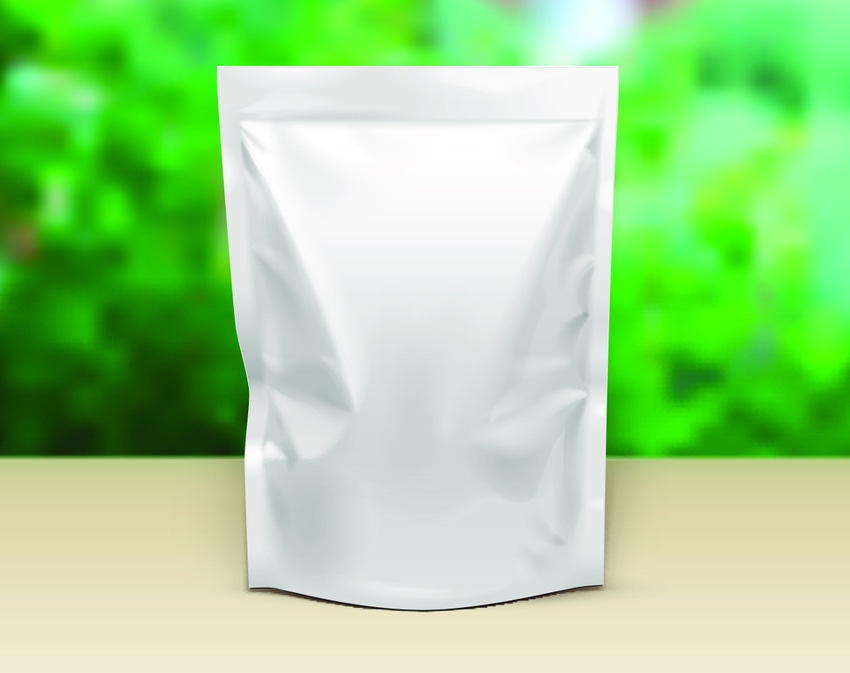
Technological innovation, sustainability concerns and attractive economics are among the reasons for the phenomenal growth of flexible packaging in the last two decades in the U.S. With an estimated $31 billion in sales in 2017, according to the Flexible Packaging Assn., brand owners are embracing films, pouches and bags as a go-to packaging solution, thanks in part to wide acceptance by American consumers.
But we’re also seeing aluminum sourcing concerns because of U.S. tariffs, as well as major competitive moves—reflected, for example, by the recent Amcor acquisition of Bemis.
With flexible packaging so much in the spotlight, Packaging Digest wanted to see what is shifting in the market. So we conducted a virtual roundtable with five industry experts from various areas in the supply chain: resin supplier Nova Chemicals; printing press maker Comexi; extrusion/coating equipment company Davis-Standard; converter Berry Global; and form-fill-seal machinery manufacturer Pro Mach.
Their insights show how this dynamic market continues to advance, despite some challenges.
Here are the questions we asked:
1. What top trends are you seeing in flexible packaging and why? What are the drivers?
2. What challenges is the flexible packaging market encountering now and how are they being addressed?
3. Where do you see the biggest growth for flexible packaging moving forward and why?
4. What, if anything, is different about the sustainability message of flexible packaging today versus, say, two or three years ago?

Now, the insights from…
Jonathan Quinn, performance films market development manager, Nova Chemicals, a plastics and chemical company that makes resins for flexible packaging.
Raúl El-Fakdi, flexo brand manager, Comexi, a family-run manufacturer of flexographic printing, offset printing, gravure printing, laminating and slitting equipment.
Louis Piffer, senior sales engineer, Davis-Standard, a designer, manufacturer and supplier of plastics and rubber processing equipment, and extrusion technology and extruder converting systems.
Tarun Manroa, evp and general manager, engineered materials division, Berry Global, a Fortune 500 global manufacturer and marketer of plastic packaging products, including pouches.
Troy Snader, svp, flexible packaging, Pro Mach, a comprehensive provider of complete packaging machinery solutions, from line design to the end of the line and beyond.
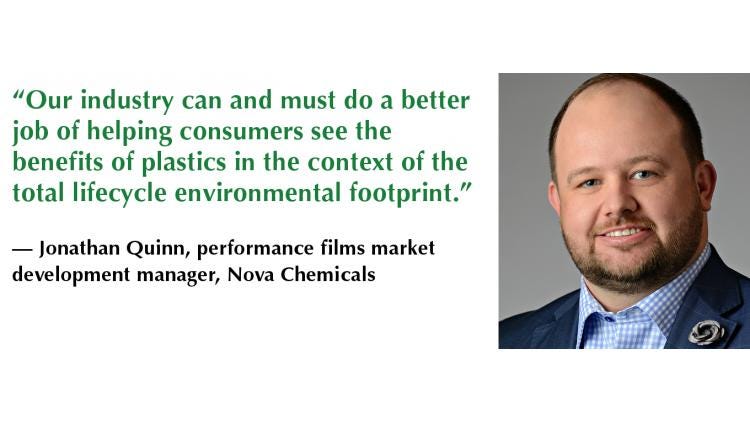
Jonathan Quinn, performance films market development manager, Nova Chemicals, a plastics and chemical company that makes resins for flexible packaging.
What top trends are you seeing in flexible packaging and why? What are the drivers?
Quinn: From an economic perspective, trends like consolidation—such as Amcor’s announcement to acquire Bemis—clearly will continue, and we also will see some further uncertainty related to the trade war. Regardless, we believe that packaging trends in the North American market place are driven by the consumer. And three major consumer trends are sustainability, convenience and ecommerce.
1. Sustainability: Shifting demographics and consumer preferences are driving the demand for more sustainable solutions, in packaging and far beyond. Negative publicity around ocean gyres and plastic-filled beaches only add to the urgency to increase recyclability, curbside collection, sorting capabilities and finally innovation to increase demand for recyclable materials. Rigid-to-flexible conversion, with its huge sustainability benefits, has been a trend for some time now. Add to all of these the opportunities resulting from more cost-effective and technologically feasible recyclable packaging solutions available today, and sustainability is at the top of everyone’s list.
We are at a unique point in the history of flexible packaging. According to the New Plastics Economy, major brand owners and retailers—including Danone, Mars, PepsiCo and Coca-Cola, and Walmart—are working towards goals around all reusable, recyclable or compostable packaging, and these initiatives are speeding the shift to recyclable flexible packaging.
There is also a significant push by flexible packaging companies for sustainable packaging today. All in all, we’re seeing a critical mass of players moving the needle, after many years of talking about the need for action.
2. Convenience, convenience, convenience! The consumer of today is very different than that of the traditional consumer 20 years ago. The younger generations’ typical lifestyle is busier and busier, and at the same time, they’re looking for healthier options—that often require performance packaging. Everyone is on the go and these buyers want the products they consume to be delivered quickly, consumed easily and disposed of efficiently.
3. Ecommerce: Ecommerce is a game-changing example of the convenience trend. Its efficiencies, coupled with the ease of comparison shopping, are also driving down prices in many sectors. As Business Insider reports, ecommerce is driving virtually all retail growth, and its impact on flexible packaging will grow with it.
According to FMI, the online grocery market alone may reach $100 billion by 2022. Better performing flexible packaging solutions—especially seal integrity and abuse resistance so products arrive at the consumer’s door intact—will be a must to support the more rigorous ecommerce supply chain.
What challenges is the flexible packaging market encountering now and how are they being addressed?
Quinn: We see three challenges, as well.
1. Speed of transformative change: The biggest challenge we see moving forward is innovating at the rate of speed required to keep up with rapidly evolving business models. The meal kits delivery business is a great example. In 2018, we are going to get a good idea if this market segment is going to sink or swim. A key driver for it to survive and thrive will be packaging performing at the highest levels, providing consumer confidence that every week their food will arrive fresh and safe to consume. The “safe to consume” aspect will be that the products be efficiently packaged in well insulated secondary package. In addition, meal kit customers feel the amount of packaging is excessive and non-recyclable, according to a Packaged Facts report, so primary and secondary packaging will also have to have a sustainable format.
2. Consumer perception of plastics: Anti-plastics sentiment continues to rise, both in absolute numbers and relative to perceptions of alternative materials. Consumers are being exposed to media and publications showcasing the negative aspects of one-time-use plastics. Municipal bag bans are cropping up and companies like McDonald’s are discontinuing the use of styrenics, among other moves across the globe.
Our industry can and must do a better job of helping consumers see the benefits of plastics in the context of the total lifecycle environmental footprint. We need to go even further, and help to develop the circular economy, which today is just starting to take shape.
3. Personalizing the consumer experience: Everything from Coke bottles and cans to candy bars are being marketed as a unique experience for each and every consumer. This trend started in the digital realm and now younger consumers especially expect it with their goods as well. As a result, companies are being forced to find new ways to connect with consumers and give them an individualized experience. The challenge lies both in increased costs to deliver on this experience, and the enormous logistical challenges in implementation.
Where do you see the biggest growth for flexible packaging moving forward and why?
Quinn: The big trends noted above are the main drivers of growth in flexible packaging. Here’s why…
Sustainability: A lot of growth in flexible packaging is about conversion that improves sustainability. The first wave was in rigid to flexible, which continues to grow the flexible market tremendously while reducing total lifecycle environmental impact as noted above. The next wave is the move to mono-material and other recyclable film structures, whether from non-recyclable multi-material construction or leapfrog conversions from alternative materials. We see the advent of recyclable performance packaging accelerating the growth of flexible packaging tremendously.
Convenience: Kids have been leading the way in some respects in single serve and on-the-go packaging. Examples include packs of apple slices and carrot sticks, pureed baby food in SUPs with fitments and now squeeze packs of applesauce, or going way back to things like Lunchables. We’re now seeing expansion in products like this marketed to adults. Brands are introducing products like retort oatmeal in a SUP with a fitment, and we’re even starting to see convenience products in the produce aisle. For example, Dole is now offering pineapple and watermelon individually sliced and wrapped in a flow wrap, then collated into a secondary package.
Granola and protein bars really speak to this trend and growth, even though we don’t think of them this way. They’re designed to be the perfect on the go refuel!
3. Ecommerce: We’ll see growth in ecommerce flexible packaging related to application customization. The major drivers—“frustration free” packaging and “ships in own container”—enhance the consumer experience and they’re going to drive flexible into applications where it has not historically been. We’re seeing things like using shrink wrap over a primary packaging box instead of a second box, and products traditionally packaged in clam shells and a secondary shipping box transitioning to an easy-open, abuse-resistant, and tamper-evident pouch or other primary package format.
The sustainability benefits of lighter weight flexible packaging will also come into play in ecommerce. Converting to flexible packaging can reduce material costs, shipping costs and ease logistical challenges. These take cost out of the supply chain for the retailer and the shipper and may in turn lower the retail price for the consumer. Products which needed to be merchandised for the retail environment don’t have the same requirement when sold online, which allows for different package formats and branding.
Ultimately, the result will likely be convergence, where one package format and structure can be used for both brick and mortar and ecommerce sales. These packages will incorporate the performance and aesthetic requirement of both sales channels, and offering an overall cost advantage over multiple stock-keeping units (SKUs) for identical products.
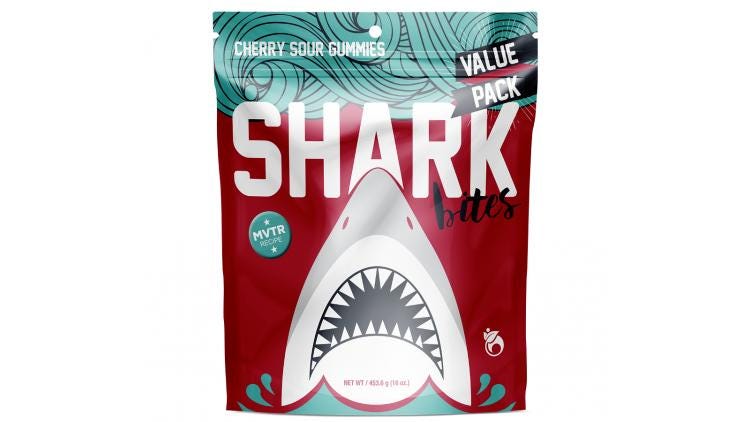
What, if anything, is different about the sustainability message of flexible packaging today versus, say, two or three years ago?
Quinn: We see a couple of different perspectives on this. First is the messaging opportunity to consumers, which often takes center stage. However, communication within the industry is also essential to developing and commercializing more sustainable packaging offerings.
Consumer messaging: Today, sustainability is a true driver of packaging innovation, where just a few short years ago it was just a buzzword. Again, shifting demographics come into play. Younger generations have a less positive perception of plastics, and sustainable packaging is an imperative to appeal to these consumers. Programs like How2Recycle label are helping consumers understand flexible packaging recycling options, and enabling brand owners to showcase package recyclability, educate consumers and ultimately drive up collection rates. Industry associations are also starting to step up with concerted efforts to promote the benefits of plastics over alternative materials, counterbalancing some of the anti-plastics sentiments we all see in the media.
Flexible packaging sustainability messaging is also focused on reducing waste in general. Newer technologies are enabling downgauging and related benefits in flexibles that reduce material consumption and waste. These packages also play a role in reducing food waste by extending shelf life and reducing spoilage from leakers and other package breaches. As a result, the messaging now is around the positive influence flexible packaging has on sustainability in the entire value chain.
In short, the message is changing. Sustainability is driving action and resources for all of us in the broader plastic packaging industry.
Within the industry: Sustainability is both a challenge and an opportunity throughout the value chain. We can’t find optimal solutions in isolation; we are all interdependent and must collaborate to develop the environmentally responsible packaging that consumers and brand owners are demanding. More and more industry players understand the sustainability opportunity today, and they understand that how we talk to each other about it is essential, as it influences how quickly and even whether a lot of innovation happens.
Also, no discussion of the sustainability of flexible plastics would be complete without noting the impact of China’s National Sword initiative. This initiative is increasing the amount of recyclable materials that need to be consumed domestically by a huge percentage. We’re going to have to think differently about how to expand the profitable uses of flexible recyclables to consume those additional materials.
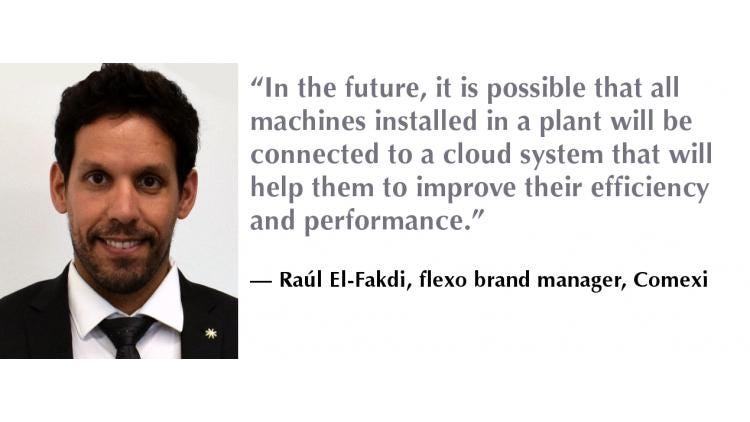
Raúl El-Fakdi, flexo brand manager, Comexi, a family-run manufacturer of flexographic printing, offset printing, gravure printing, laminating and slitting equipment.
What top trends are you seeing in flexible packaging and why? What are the drivers?
El-Fakdi: Trends affecting the whole flexible packaging printing and converting process include:
• Demand of shorter and shorter printing runs.
• Shorter times to market.
• Need of automation.
• Explosion of new market niches.
• Personalized and differentiated products are increasingly demanded.
• Increasing complex laminating structures, mainly for retort applications.
• New effects to stand out on the shelf: holographic designs, matte packaging, texturizations.
• Emergence of eco-friendly packaging.
• New applications and finishings, such as natural feeling and increase of usage of paper.
• Increase use of window packaging to see real content.
• Search for added-value packaging to differentiate from competitors.
• Personalization of the packaging.
• Easy-open packs that need laser scoring.
• Consumers and converters asking for products and packaging that are more sustainable and lengthen the useful life of food or any other product.
• Converters searching for equipment that offers speed but, above all, the highest productivity and the ability to respond efficiently to the latest needs and trends in the market.
• Mergers and acquisitions in companies.
One of the main trends is the constant need of highly efficient and sustainable equipment. Therefore, these past years, Comexi has developed its innovative offset technology, Comexi CI8, which offers more competitive prices, is 100% solventless free printing, uses electron beam (EB) inks and its plates are up to 20 times more economical than traditional ones. Due to its capabilities to offer small runs, it is highly profitable and it is a strong competitor in front of digital printing.
In the flexographic printing sector, Comexi recently launched Comexi F1 flexographic press with robot technology and an automatic changeover system for sleeves, adapters and anilox rolls. Last year, the group also launched Comexi F2 ML press, which significantly reduces the changeover time and increases production time, while improving ergonomics and safety for the operator.
Furthermore, converters are always searching for machinery that reduces downtimes and boosts its productivity. Comexi F1 increases production by 30%, allowing printers to handle 30% more jobs per year.
Another key element is ergonomics and usability. Comexi flexographic presses can be equipped with 100% full line inspection, automatic pressure and register during ramp up of the machine, an inline spectrophotometer and, in offset printing, closed-loop color matching.
Moreover, we have detected an increasing demand for water-based rotogravure, which in terms of sustainability, fits perfectly well with our corporate pillars and strategy.
Every day, the market is demanding more customized products, so job lengths are getting shorter. At the same time, customers ask for better products in terms of shelf life and usability. It means more complex structures, and many different kinds of materials, some with specific coating and laminating needs that have to be easily interchangeable.
Companies are being forced to lead with complexity and a rise of stock-keeping units (SKUs) and “added value” solutions, like easy-open packs, so enterprises need slitters and rewinders able to deal with more complicate jobs and able to avoid being stopped. Reducing downtimes and fast changeover is critical. In this sense, a simple machine can be working just 30% of the time. Comexi can improve this ratio up to 70% if the customer uses our added-value solutions available, such as double turret rewinders, automatic knife positioning, automatic core positioning or automatic taping, among many others.
And even these upgrades can be improved if the converters automate all the steps that occur after the slitting process, such as labeling, wrapping or palletizing using robots connected to Comexi slitters. This improvement is one of the main ways to drastically reduce downtimes.
In the future, it is possible that all machines installed in a plant will be connected to a cloud system that will help them to improve their efficiency and performance. Not only on giving them different ratios for key performance indicators (KPIs), but also giving them recommendations on how to produce the jobs.
Last but not least, we have seen that, more and more, printers and converters ask for software and tools that provide real time and online data about production speeds to optimize performance. Therefore, we developed the Comexi Cloud tool, the jump to Industry 4.0. This offers online data about production speeds, production output, productivity, set-up times, number of reels produced, and downtime for preventive maintenance and repairs. This tool provides the convertor insights in how to optimize the production efficiency of its production orders. It goes even further with analytics on job costs, based on production time, film, inks and energy consumption. With this system, factories and brand owners can see and understand their data and process to facilitate optimal decision-making. Tracks work every day at any time improving efficiency and analyzing productive and non-productive meters, execution time and trends in work and production.
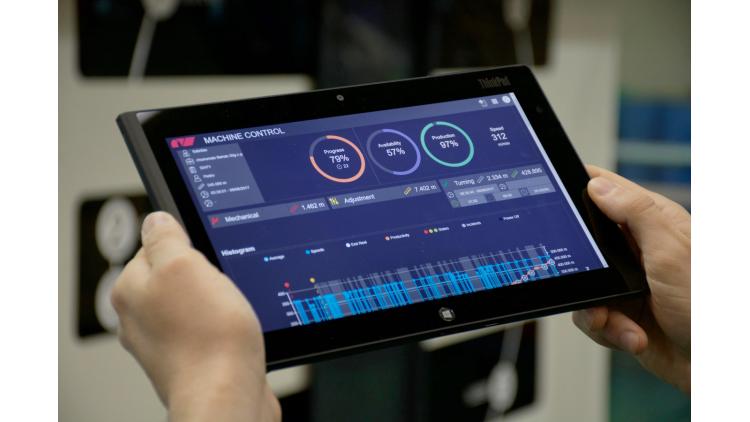
Comexi Cloud tool.
What challenges is the flexible packaging market encountering now and how are they being addressed?
El-Fakdi: Industry 4.0 and IoT (Internet of Things) will rapidly become more important and we think that could be one of the main challenges in the flexible packaging market. The jobs carried out by printing and converting machinery in the flexible packaging sector are becoming more and more demanding due to the requirements of the new products and formats that are continuously appearing for the different profiles of consumers and requests. This reality means clients have had to settle in a state of continuous improvement, permanently optimizing their resources and processes.
That is why we are convinced that being aware and keeping up to date with everything that happens with the printing and converting processes is crucial, the same way that we monitor and study our sports activities with the aim of improving and being more competitive. These were the main elements that propel the creation of Comexi Cloud. What are the most relevant incidents that affect my production? How long does a mechanical change or adjustment take? What is the availability of the machine? What is being performed at this precise moment? These are just some of the questions that can be answered rapidly with Comexi Cloud, from anywhere and using any type of device.
Comexi Cloud is based on an open Amazon IT-platform enabling complete plant management information and control. Apart from that, in technical field services, we are studying a test with ER (Extended Reality) to provide remotely technical on-site support through our customers’ maintenance engineers.
Following previous indications, all analysis shows important changes on consumer habits and increasing of personal packaging expenses, as well as changes on the type of packaging—rigid to flexible packaging, for example.
Some other main challenges? Converters and printers ask for automation and we have developed equipment that offers a high degree of automation and robotization in all machines, as well as adjustment systems to make the machine more autonomous to answer flexible packaging industry and whole market requests.

Comexi robotics for automation.
Where do you see the biggest growth for flexible packaging moving forward and why?
El-Fakdi: Asia is one of the main future markets in flexible packaging. Consumer habits, population growth, average expenses per person in packaging market and increasing demands are some of the characteristics that have marked this region. Global studies and analysis show a high increase in the Asian’s packaging and flexible packaging sector. Therefore, it is an important market because of its high volume.
These are some of the main reasons why Comexi has improved a lot of its approach and resources to the Asian markets, especially the south Asian territories, during these last five years. Besides, we are still counting on new and challenging investment plans today and for the long term.
Also, other growing markets are North America, the Middle East and Africa (MEA). On a global scale, the largest flexible packaging market in terms of value is North America, followed by Europe with the highest spend per capita in flexible packaging. However, the growth of the flexible packaging market is undoubtedly in Asia and MEA with an expected increase of spend per capita by the middle class with the growth of the population. This creates interesting opportunities as demand for printing presses and converting equipment will strongly increase.
Companies and brands located in Asia are really interested in high eye-catching visual effects. Therefore, the innovative Comexi Futura machine, which is able to apply holography on flexible packaging films through cast and cure technology, has been successful in this area. This kind of technology provides vibrant images with some exclusive features, producing high added-value packaging.
New businesses are being started in this region by local people who will benefit from the increase in demand for flexible packaging. Besides, new investors are also investing in flexible packaging companies, which further boosts this market. Also, further consolidation of flexible packaging convertors is expected, which will result in a consolidation of factories and strategic investment plans in converting equipment in this region.
What, if anything, is different about the sustainability message of flexible packaging today versus, say, two or three years ago?
El-Fakdi: We could say that sustainable solutions are no longer limited to corporate statements. The industry has proved to be able to develop sustainable technologies on a cost-effective basis and with the quality standards required by the market. For example, Comexi offset printing technology is a 100% solvent-free solution and food safety certified. Another good example is the development of EB-cured inks for flexographic printing. Governments and industry leaders will continue to make joint efforts to reduce the carbon footprint by stimulating innovations in this direction.
In this sense, the newest developments in curing inks (from EB to ultraviolet/UV and UV LED) prove to be more stable and profitable than its predecessors. The demand for sustainable and solvent-free alternatives—and the appearance of new regulations that restrict, or even ban, the use of solvents—is pushing the ink manufacturers to accelerate the development of alternative inks. Once stability is solved, it’s time to increase press efficiency and performance to push profitability to solvent printing levels.
Regarding laminating, solventless adhesives have improved their performance rapidly, and Comexi laminators have adapted to this new trend. Thanks to its sleeve technology, the job only takes two minutes, and the new dosing adjustment from the main machine screen is helping operators control production quality while running at top speed. The new generation of top-of-the-range laminators have a mechanical speed of 500 meters per minute, allowing them to reach the highest production rates.
Water-based adhesives have also significantly improved their performance and can now be used in almost every single application. Thanks to its ultra-fast curing time-to-market, final products can be delivered in the shortest time.
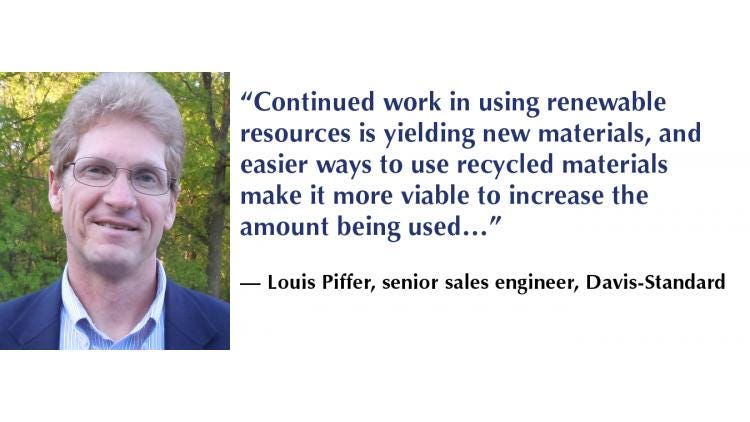
Louis Piffer, senior sales engineer, Davis-Standard, a designer, manufacturer and supplier of plastics and rubber processing equipment, and extrusion technology and extruder converting systems.
What top trends are you seeing in flexible packaging and why? What are the drivers?
Piffer: Companies want to be able to run shorter runs more economically. This involves reducing the downtime between running one product to another, which requires less purge time and faster equipment reconfiguration. Fortunately, recent work in adapter and screw design, along with proper purging techniques, can reduce purge times. Faster equipment reconfiguration has been available for some time, it’s just a question of the level of automation required.
What challenges is the flexible packaging market encountering now and how are they being addressed?
Piffer: I have constantly heard plant managers bemoaning the fact that they can’t get good operators and helpers. Lower unemployment level may be good for our country, but it can play havoc with flexible packaging staffing. As an equipment manufacturer, we get asked to provide a line with the proverbial “easy button.” They don’t want a line where the quality of the end product is based mainly on the experience of the operator. To do this, greater automation is required, and variables possibly left to the whims of the operator are being documented, tracked and controlled.
Where do you see the biggest growth for flexible packaging moving forward and why?
Piffer: The growth opportunities remain in the barrier segment with brand owners and converters looking for higher barrier structures to extend shelf life and reduce the need for preservatives and other non-organic additives. Today, market trends are driven by our aging population, as well as the emergence of the Millennials. The successful converter needs to incorporate features that address those trends, such as greater convenience, portion packaging and reduced amount of packaging materials. These features can be key to differentiate a given brand and expand product offerings.
In terms of technology, the increased use of digital printing as part of the converting chain is a growing trend to meet the needs of the market. By surface printing and lacquer coating a pre-lam material as opposed to laminating a reverse-printed film, the converter can realize a cost advantage by printing on demand, which can reduce waste and allow fewer product changes on their extrusion coating lines.
What, if anything, is different about the sustainability message of flexible packaging today versus, say, two or three years ago?
Piffer: The message has not changed much but the reality of what can be done is more aligned with the goals being set. Continued work in using renewable resources is yielding new materials, and easier ways to use recycled materials make it more viable to increase the amount being used—but the challenge remains in closing the gap between the increased cost and the expectation from brand owners not wanting to pay a premium for using these materials.
New equipment is energy efficient, and new technology and automation have reduced the amount of waste being generated, as well as have improved its value in the recycle stream. But this is just the first step in the process. Continued work in source reduction is needed to eliminate “over packaging” by moving to simpler structures utilizing high-performance materials.
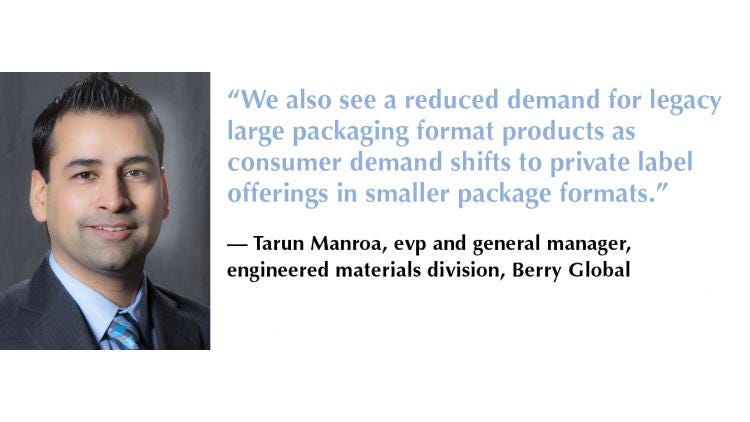
Tarun Manroa, evp and general manager, engineered materials division, Berry Global, a Fortune 500 global manufacturer and marketer of plastic packaging products, including pouches.
What top trends are you seeing in flexible packaging and why? What are the drivers?
Manroa: We see five top trends:
1. Continued pressure to reduce packaging cost. Consumers moving away from more processed, carb-rich foods are driving a shortfall in sales for packaging of those products. Food companies are responding with cost savings and new product introductions. We have seen an increase in gauge reduction, lower cost materials and margin pressure. We also see a reduced demand for legacy large packaging format products as consumer demand shifts to private label offerings in smaller package formats.
2. Market push for cleaner labels with more recognizable ingredients. This means an increased pressure to improve package performance to protect these new foods, eliminating the need for food preservatives, while still meeting cost targets.
3. Rigid to flexible conversion. We have seen a continued growth in stand-up pouches as a replacement for rigid containers to reduce material content.
4. Ecommerce growth. We have also noticed the shift from retail shopping to online shopping, driving the need for home deliveries.
5. Sustainability. This includes source reduction, down-gauging, recyclability and the use of renewable source materials.
What challenges is the flexible packaging market encountering now and how are they being addressed?
Manroa: Recycling is a challenge for all manufacturers of flexible packaging. We have seen a desire to move to packages made with homogenous material while maintaining product packaging requirements. Material and equipment suppliers are also experiencing this pressure and are working to develop technical solutions.
Changing demographics are driving a change in consumer demand for increased product choices, fresher products with less preservatives, smaller package sizes—all with better consumer convenience. We are constantly working with material and equipment suppliers to utilize technology to reduce costs for shorter run quantities and meet these challenges.
This same change in demographics is reducing sales for mega-brands, thus driving the need for consumer packaged goods companies (CPGs) to reduce product/packaging costs. We are meeting these changes through creative material substitutions and down-gauging.
As the market changes, new equipment must be flexible and meet these ongoing needs.
Where do you see the biggest growth for flexible packaging moving forward and why?
Manroa: We are keeping a pulse on the shift in consumer demand from retail to online purchasing and home delivery. These have the potential to increase the total packaging material content/product.
Another growth area is material conversion, specifically replacing paper with plastic.
And we see flexible packaging growing in popularity and acceptance when compared to rigid packaging.
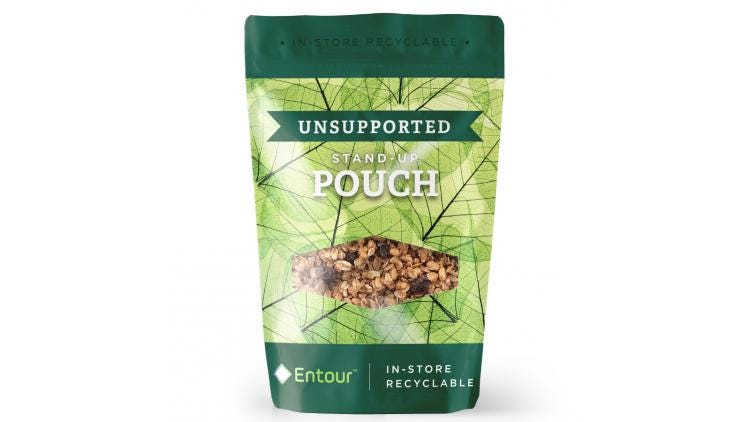
What, if anything, is different about the sustainability message of flexible packaging today versus, say, two or three years ago?
Manroa: Sustainability positions of CPGs, large retailers and other large companies are becoming formalized with clearer objectives.
And the industry has a better understanding of the complexity, environmental impact and need for change.
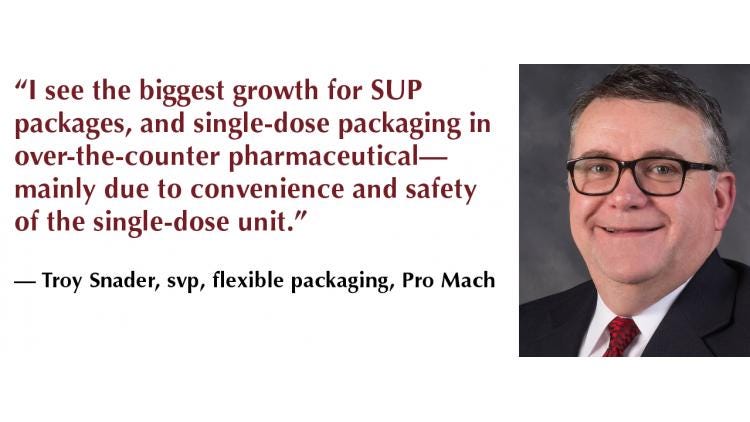
Troy Snader, svp, flexible packaging, Pro Mach, a comprehensive provider of complete packaging machinery solutions, from line design to the end of the line and beyond.
What top trends are you seeing in flexible packaging and why? What are the drivers?
Snader: We’re seeing a change in packages from pillow bags to standup pouches (SUP) and “shaped” packages. Also, smaller and larger packages (more stock-keeping units/SKU’s in general).
Drivers are grocers and consumers looking for front-panel graphics and diversity of end users for single-serve packages to “club store” packages for large quantities.
What challenges is the flexible packaging market encountering now and how are they being addressed?
Snader: Among the challenges are the ability to have “one machine fits all,” plus new innovations and acquisitions for providing any solution for any package.
Where do you see the biggest growth for flexible packaging moving forward and why?
Snader: I see the biggest growth for SUP packages, and single-dose packaging in over-the-counter pharmaceutical—mainly due to convenience and safety of the single-dose unit.
What, if anything, is different about the sustainability message of flexible packaging today versus, say, two or three years ago?
Snader: We’re seeing more starch based films now.
About the Author(s)
You May Also Like




